佛教英文介绍
常见佛教英语
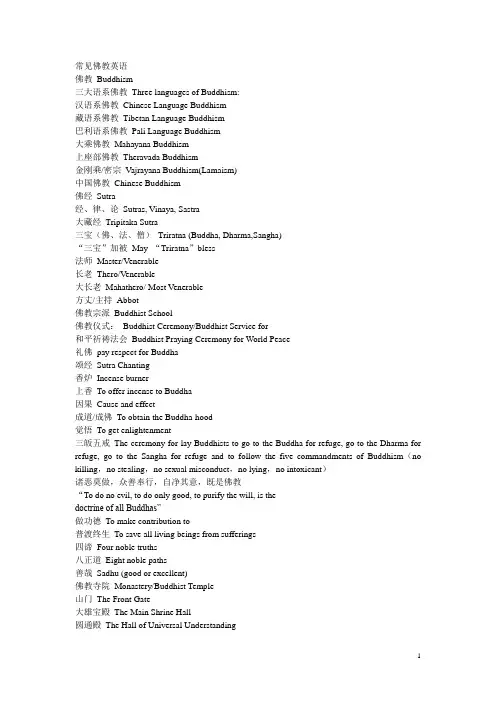
常见佛教英语佛教Buddhism三大语系佛教Three languages of Buddhism:汉语系佛教Chinese Language Buddhism藏语系佛教Tibetan Language Buddhism巴利语系佛教Pali Language Buddhism大乘佛教Mahayana Buddhism上座部佛教Theravada Buddhism金刚乘/密宗Vajrayana Buddhism(Lamaism)中国佛教Chinese Buddhism佛经Sutra经、律、论Sutras, Vinaya, Sastra大藏经Tripitaka Sutra三宝(佛、法、僧)Triratna (Buddha, Dharma,Sangha)“三宝”加被May “Triratna”bless法师Master/Venerable长老Thero/Venerable大长老Mahathero/ Most V enerable方丈/主持Abbot佛教宗派Buddhist School佛教仪式:Buddhist Ceremony/Buddhist Service for和平祈祷法会Buddhist Praying Ceremony for World Peace礼佛pay respect for Buddha颂经Sutra Chanting香炉Incense burner上香To offer incense to Buddha因果Cause and effect成道/成佛To obtain the Buddha-hood觉悟To get enlightenment三皈五戒The ceremony for lay Buddhists to go to the Buddha for refuge, go to the Dharma for refuge, go to the Sangha for refuge and to follow the five commandments of Buddhism(no killing,no stealing,no sexual misconduct,no lying,no intoxicant)诸恶莫做,众善奉行,自净其意,既是佛教“To do no evil, to do only good, to purify the will, is thedoctrine of all Buddhas”做功德To make contribution to普渡终生To save all living beings from sufferings四谛Four noble truths八正道Eight noble paths善哉Sadhu (good or excellent)佛教寺院Monastery/Buddhist Temple山门The Front Gate大雄宝殿The Main Shrine Hall圆通殿The Hall of Universal Understanding观音殿The Hall of Avalokitesvara Buddhisatva藏经阁The Tripitaka Sutra Pavilion罗汉堂The Hall of Arhan祖师殿The Hall of Patriarch四大天王Four deva-kings, the protectors of Buddhism韦驮Vitasoka/Vigatasoka, the protector of Buddhism斋堂Monastic Dinning Hall客堂Monastic Reception四大名山:Four holy mountains of Chinese Buddhism五台山Wutai Mountain is the Holy Place of Manjusri Buddhisattva峨嵋山Ermei Mountain is the Holy Place of Mahasthama Buddhisattva 九华山Jiuhua Mountain is the holy place of Ksitigarbha Buddhisattva 普陀山Putuo Mountain is the holy place of Avalokitesvara Buddhisattva 佛像Buddha statue释迦牟尼佛Shakyamuni Buddha弥勒佛Maitreya Buddha迦叶佛Kasyapa Buddha阿弥陀佛Amitaba Buddha毗庐舍那佛Vairocana Buddha药师佛Bhaisajya Buddha/medicine Buddha三世佛Buddhas of Three Periods:Kasyapa Buddha of the pastShakyamuni Buddha of the present,Maitrya Buddha of the future菩萨Buddhisattva观世音菩萨Avalokitesvara Buddhisattva菩贤菩萨Samandhabatra Buddhisattva大势智菩萨Mahasthamaprapta Buddhisattva文殊菩萨Manjusri Buddisattva地藏菩萨ksitigahba Buddhisattva善财童子Sudhana罗汉Arhan西方三圣:阿弥陀佛、观音菩萨、大势至菩萨Amitaba BuddhaAvalokitesvara BuddhisattvaMahasthamaprapta Buddhisattva达摩Budhidharma摩腾Kasyapa Matanga竺法兰Gobharana/Dharmaraksa佛学院Buddhist College僧伽Sangha僧、尼(比丘、比丘尼)monk、nun /Bhiksu, Bhiksuni方丈/主持Abbot首座Chief monk监院/当家Monastic Manger侍者Assistant中国佛教协会The Buddhist Association of China中国佛学院The Buddhist Academy of China会长President副会长Vice President秘书长Secretary General副秘书长Deputy Secretary General佛学英语词汇the Great Vehicle d大乘the Lesser Vehicle 小乘the Diamond Vehicle 金刚乘Four Noble Truths 四圣谛苦suffering集causes of suffering灭suppression of suffering 道path to suppression of sufferingTwelve Links in the Chain of Causation 十二因缘cycle of rebirths 轮回ignorance 惑nirvana 涅磐greed 贪hatred 嗔stupidity 痴pride 慢hesitation 疑wrong view 恶见no-soul 无我impermanence 无常sentient beings 众生deva 天human 人asura 阿修罗animal 畜牲hungry ghost 饿鬼denizen of hell 地狱morality 戒concentration 定wisdom 慧action 身speech 口consciousness 意lay Buddhists 居士novice monks 沙弥monks 比丘Five Precepts 五戒personal enlightenment 自觉universal enlightenment 觉他full enlightenment 觉满Buddha of Medicine 药师佛Buddha Maitreya 弥勒佛body of essence 法身award body 报身body of transformation 化身Four Heavenly Kings 四天王karma 因果Buddha Amitaba 阿弥陀佛Buddha of Sunlight (法身佛)毗卢遮那佛Buddha Sakyamuni 释迦牟尼佛Bodhisattva of Compassion 观音菩萨Boohisattva of Ultimate Knowledge 文殊菩萨Bodhisattva of Universal Benevolence 普贤菩萨Bodhisattva of Great Power 大势至菩萨bodhi 菩提dhyana 禅那sangha 僧团saha 娑婆五蕴five aggregates色aggregate of material body受aggregate of feelings想aggregate of perceptions 行aggregate of predispositions识aggregate of consciousness简单佛学英语Birth is suffering; aging is suffering;生是苦;老是苦;sickness is suffering; death is suffering;病是苦;死是苦;association with the unpleasant is suffering;怨憎会是苦;dissociation from the pleasant is suffering;爱别离是苦;not to get what one wants is suffering;求不得是苦;in short, attachment to the five aggregates is suffering.简言之,对五蕴的执取就是苦。
中国四大佛教名山,英文
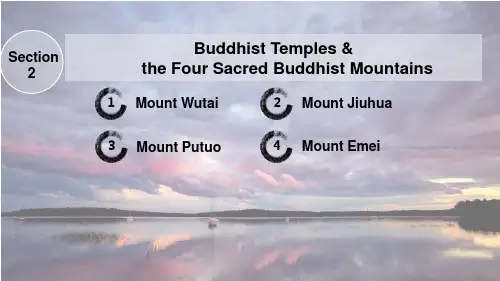
Which is the most worshiped sacred place? What is the Mount Emei known for?
Bye Bye
For more information please scan this
Section 2
Buddhist Temples & the Four Sacred Buddhist Mountains
1 Mount Wutai
2 Mount Jiuhua
3 Mount Putuo
4 Mount Emei
Buddhist Temples
1 Pagodas(塔) 2 Temple 3 Grottos(石窟)
Known for : stiff cliffs, highrising peaks, roaring waterfalls, gurgling springs, towering ancient trees, fragrant flowers
对佛教的认识和感悟英文作文
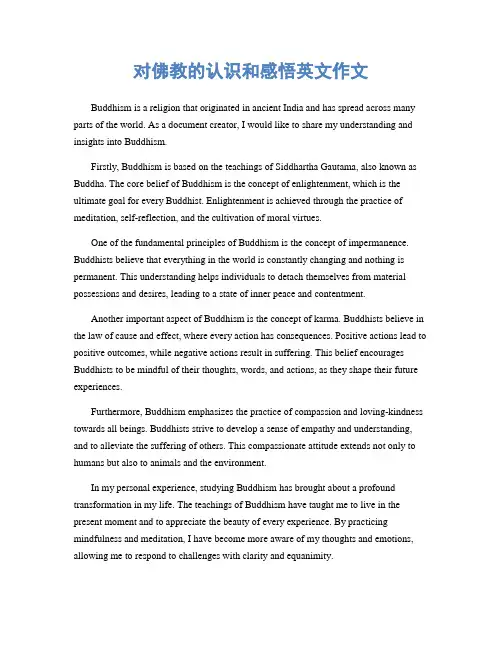
对佛教的认识和感悟英文作文Buddhism is a religion that originated in ancient India and has spread across many parts of the world. As a document creator, I would like to share my understanding and insights into Buddhism.Firstly, Buddhism is based on the teachings of Siddhartha Gautama, also known as Buddha. The core belief of Buddhism is the concept of enlightenment, which is the ultimate goal for every Buddhist. Enlightenment is achieved through the practice of meditation, self-reflection, and the cultivation of moral virtues.One of the fundamental principles of Buddhism is the concept of impermanence. Buddhists believe that everything in the world is constantly changing and nothing is permanent. This understanding helps individuals to detach themselves from material possessions and desires, leading to a state of inner peace and contentment.Another important aspect of Buddhism is the concept of karma. Buddhists believe in the law of cause and effect, where every action has consequences. Positive actions lead to positive outcomes, while negative actions result in suffering. This belief encourages Buddhists to be mindful of their thoughts, words, and actions, as they shape their future experiences.Furthermore, Buddhism emphasizes the practice of compassion and loving-kindness towards all beings. Buddhists strive to develop a sense of empathy and understanding, and to alleviate the suffering of others. This compassionate attitude extends not only to humans but also to animals and the environment.In my personal experience, studying Buddhism has brought about a profound transformation in my life. The teachings of Buddhism have taught me to live in the present moment and to appreciate the beauty of every experience. By practicing mindfulness and meditation, I have become more aware of my thoughts and emotions, allowing me to respond to challenges with clarity and equanimity.Moreover, Buddhism has taught me the importance of letting go of attachments and desires. By understanding that material possessions and external circumstances do not define my happiness, I have learned to find contentment within myself. This has brought me a sense of inner peace and freedom from the constant pursuit of worldly desires.Additionally, Buddhism has provided me with a moral compass to guide my actions. The principles of non-violence, honesty, and integrity have become the foundation of my ethical conduct. By cultivating these virtues, I strive to contribute positively to society and to create harmony in my relationships.In conclusion, Buddhism offers a profound understanding of life and the human condition. Its teachings on impermanence, karma, compassion, and mindfulness provide a roadmap for personal growth and spiritual development. Through my exploration of Buddhism, I have gained valuable insights and practices that have enriched my life in countless ways. I am grateful for the wisdom and guidance that Buddhism has imparted to me, and I continue to deepen my understanding and practice of this ancient tradition.。
佛教词汇翻译
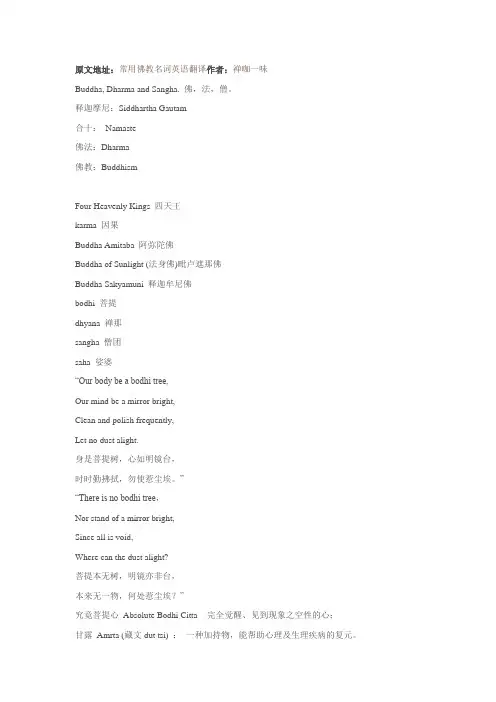
原文地址:常用佛教名词英语翻译作者:禅咖一味Buddha, Dharma and Sangha. 佛,法,僧。
释迦摩尼:Siddhartha Gautam合十:Namaste佛法:Dharma佛教:BuddhismFour Heavenly Kings 四天王karma 因果Buddha Amitaba 阿弥陀佛Buddha of Sunlight (法身佛)毗卢遮那佛Buddha Sakyamuni 释迦牟尼佛bodhi 菩提dhyana 禅那sangha 僧团saha 娑婆“Our body be a bodhi tree,Our mind be a mirror bright,Clean and polish frequently,Let no dust alight.身是菩提树,心如明镜台,时时勤拂拭,勿使惹尘埃。
”“There is no bodhi tree,Nor stand of a mirror bright,Since all is void,Where can the dust alight?菩提本无树,明镜亦非台,本来无一物,何处惹尘埃?”究竟菩提心Absolute Bodhi Citta - 完全觉醒、见到现象之空性的心;甘露Amrta (藏文dut tsi) :一种加持物,能帮助心理及生理疾病的复元。
阿罗汉Arhat (藏文Dra Chompa):已净除烦恼障的小乘修行者暨成就者。
他们是完全了悟的声闻或独觉(或称缘觉)圣者。
观音菩萨AvalOkiteSVara (藏文ChenreZig):大悲心本尊,是西藏人最广为修持的本尊,因此被尊为西藏之怙佑者。
观音菩萨的心咒是「嗡嘛呢贝美吽」,六字大明咒或六字明咒。
中阴(藏文Bardo):字义为「介于两者之间」。
中阴总共有六种,一般指的是介于死亡及再度受生之间的状态。
菩提心BodhiCitta (藏文Chang Chup Sem):义为「开悟或证悟之心」。
杭州净慈寺英文介绍
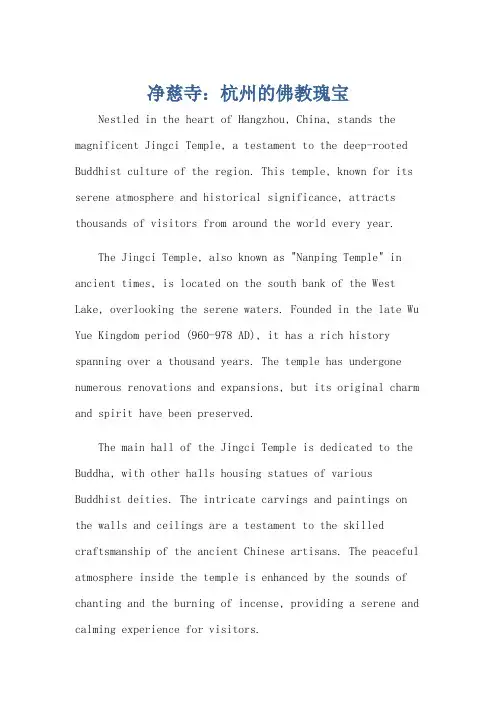
净慈寺:杭州的佛教瑰宝Nestled in the heart of Hangzhou, China, stands the magnificent Jingci Temple, a testament to the deep-rooted Buddhist culture of the region. This temple, known for its serene atmosphere and historical significance, attracts thousands of visitors from around the world every year.The Jingci Temple, also known as "Nanping Temple" in ancient times, is located on the south bank of the West Lake, overlooking the serene waters. Founded in the late Wu Yue Kingdom period (960-978 AD), it has a rich history spanning over a thousand years. The temple has undergone numerous renovations and expansions, but its original charm and spirit have been preserved.The main hall of the Jingci Temple is dedicated to the Buddha, with other halls housing statues of various Buddhist deities. The intricate carvings and paintings on the walls and ceilings are a testament to the skilled craftsmanship of the ancient Chinese artisans. The peaceful atmosphere inside the temple is enhanced by the sounds of chanting and the burning of incense, providing a serene and calming experience for visitors.The Jingci Temple is also famous for its associationwith the legendary monk济公, known for his wisdom and humor. Many stories and legends are associated with this temple, making it a popular destination for both religious pilgrims and history buffs.In addition to its religious significance, the Jingci Temple is also renowned for its beautiful gardens and landscapes. The temple compound is filled with lush greenery, flowers, and trees, providing a peaceful and serene environment for visitors to relax and enjoy nature. The West Lake, just a stone's throw away, offers additional scenic beauty and is a popular spot for boating and walking. The Jingci Temple also hosts various cultural and religious events throughout the year, attracting peoplefrom all over the world. These events range from Buddhist chanting and meditation sessions to cultural exhibitionsand performances, providing a window into the rich cultural heritage of Hangzhou.In conclusion, the Jingci Temple is not just areligious institution; it is a symbol of Hangzhou's rich history and culture. Its serene atmosphere, historicalsignificance, and beautiful landscapes make it a must-visit destination for anyone visiting Hangzhou. Whether you are a religious pilgrim seeking inner peace or a history buff interested in exploring the rich cultural heritage of China, the Jingci Temple will provide you with an unforgettable experience.**净慈寺:杭州的佛教瑰宝**在中国杭州的心脏地带,矗立着壮丽的净慈寺,这是该地区深厚佛教文化的见证。
常用佛教名词英语翻译
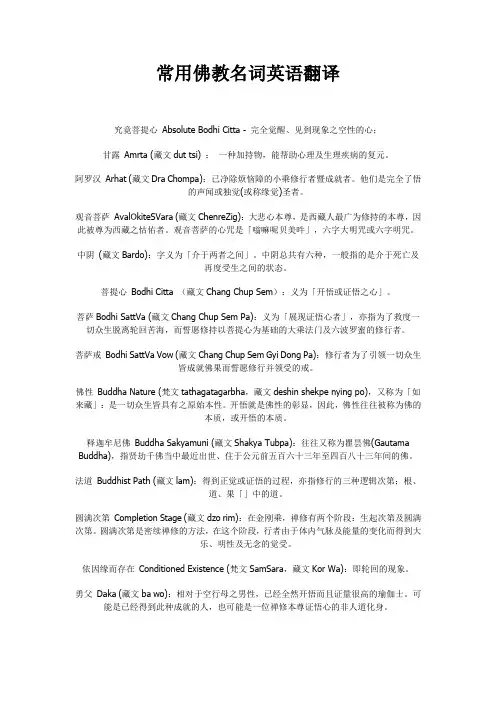
常用佛教名词英语翻译究竟菩提心Absolute Bodhi Citta - 完全觉醒、见到现象之空性的心;甘露Amrta (藏文dut tsi) :一种加持物,能帮助心理及生理疾病的复元。
阿罗汉Arhat (藏文Dra Chompa):已净除烦恼障的小乘修行者暨成就者。
他们是完全了悟的声闻或独觉(或称缘觉)圣者。
观音菩萨AvalOkiteSVara (藏文ChenreZig):大悲心本尊,是西藏人最广为修持的本尊,因此被尊为西藏之怙佑者。
观音菩萨的心咒是「嗡嘛呢贝美吽」,六字大明咒或六字明咒。
中阴(藏文Bardo):字义为「介于两者之间」。
中阴总共有六种,一般指的是介于死亡及再度受生之间的状态。
菩提心Bodhi Citta (藏文Chang Chup Sem):义为「开悟或证悟之心」。
菩萨Bodhi SattVa (藏文Chang Chup Sem Pa):义为「展现证悟心者」,亦指为了救度一切众生脱离轮回苦海,而誓愿修持以菩提心为基础的大乘法门及六波罗蜜的修行者。
菩萨戒Bodhi SattVa Vow (藏文Chang Chup Sem Gyi Dong Pa):修行者为了引领一切众生皆成就佛果而誓愿修行并领受的戒。
佛性Buddha Nature (梵文tathagatagarbha,藏文deshin shekpe nying po),又称为「如来藏」:是一切众生皆具有之原始本性。
开悟就是佛性的彰显,因此,佛性往往被称为佛的本质,或开悟的本质。
释迦牟尼佛Buddha Sakyamuni (藏文Shakya Tubpa):往往又称为瞿昙佛(Gautama Buddha),指贤劫千佛当中最近出世、住于公元前五百六十三年至四百八十三年间的佛。
法道Buddhist Path (藏文lam):得到正觉或证悟的过程,亦指修行的三种逻辑次第;根、道、果「」中的道。
圆满次第Completion Stage (藏文dzo rim):在金刚乘,禅修有两个阶段:生起次第及圆满次第。
关于中国佛教的英文讲稿
WritingI’m going to talk about Buddhism in China. This is my outline.1. Sorts of Chinese Buddhism2. Famous mountains of Buddhism in China3. Famous architecture of Buddhism in China4. The Buddhist influence on China5. ConclusionFirstly, I want to show you the sorts of Chinese Buddhism.In China, both women and men can participate in the Buddhism. In the middle of China, There is Chinese traditional Buddhism. And in the North-west and South-west of China, there is Tibetan Buddhism.People in different place believe different sorts of Buddhism. But they came from one place—India. So they all have special expression. And Buddhism mainly expressed by the architecture.Secondly, let me tell you about famous mountains of Buddhism in China.Buddhism in China has the most famous four mountains. They are mount Wutai, Putuo, e’mei, Jiuhua. They are respectively located in Shanxi, Zhejiang, Sichuan, Anhui province.At the same time, many famous places such as Shaolin temple inSongshan, Leshan Buddha, the Potala Palace in Tibet are deeply remembered by people in China even all over the world. Thirdly, I will show you the famous architecture of Buddhism in China. Such as Luoyang Baima temple, Pagoda forest, Pagoda Tianning and Dayan, Grotto Mogao and Longmen, The Potala Palace and Labrang Lamasery.And then, I want to talk about the Buddhist influence on China. The population with Buddhist Belief in China is more than one hundred million. That’s a big figure because China is a no-belief country.In the middle of China, people believe Buddhism because they just want to pray for the health and peace. Only few people are real believers. Most people participate in the Buddhist activity in order to pray for something.But Tibetan Buddhism is different. People in Northwest and Southwest are real believers. They go to worship by their knees and hands. They use all of their money for Buddhism. Buddhism’s main idea—kind is the same as Chinese traditional culture. So people would like to combine them with their peaceful and kind wishes to pray for a better life. That’s why only can Buddhism believed in China.Finally, I get a conclusion.The research on Buddhism in Chinashows the influence on each other between Chinese culture and Buddhism. Maybe we don’t believe it but we must have prayed for something. Maybe we are touched by the Buddhist mountain and architecture. I believe that Buddhism has its special charm to attract us.Today we think Buddhism as a kind of culture. The mount and building reflect the characteristic of Buddhism and Chinese culture. And the influence on Chinese is positive. So Buddhism should exist and be believed by those who have the hearts of love and kind. The specific treasure that Buddhism left for us is the mount and architecture. They are the treasure of us Chinese and the world.That’s all my presentation, thank you.。
三祖禅寺英文介绍作文
三祖禅寺英文介绍作文英文:Three Ancestors Zen Temple is a famous and ancient temple in China, located in the beautiful and tranquil Wudang Mountains. The temple has a history of over 1,200 years and is considered one of the birthplaces of Zen Buddhism in China.When I first visited Three Ancestors Zen Temple, I was immediately struck by the peaceful and serene atmosphere. The temple is surrounded by lush greenery and towering mountains, creating a sense of harmony and tranquility. As I walked through the temple grounds, I could feel the centuries of history and spiritual practice that permeated the air.One of the most impressive features of the temple isits architecture. The main hall, known as the Daxiong Hall, is a magnificent structure adorned with intricate carvingsand colorful paintings. Inside, the hall houses a stunning statue of Sakyamuni Buddha, which exudes a sense of wisdom and compassion.During my visit, I had the opportunity to participate in a meditation session led by the temple's resident monks. Sitting in the quiet meditation hall, surrounded by flickering candlelight and the sound of chanting, I felt a deep sense of peace and introspection. The experience was truly transformative, and it gave me a newfound appreciation for the practice of Zen Buddhism.In addition to meditation, the temple also offers various cultural activities and events, such as calligraphy and tea ceremonies. These activities provide visitors with a deeper understanding of Chinese culture and traditions, and they offer a unique opportunity to engage with the temple's resident monks and nuns.Overall, my visit to Three Ancestors Zen Temple was a profound and enriching experience. The temple's rich history, stunning architecture, and spiritual atmosphereleft a lasting impression on me, and I left with a renewed sense of inner peace and mindfulness.中文:三祖禅寺是中国著名的古刹,位于美丽宁静的武当山上。
东山禅寺英文介绍词作文
东山禅寺英文介绍词作文英文回答:Dongshan Temple, also known as Dongshan Zen Monastery,is a renowned Buddhist temple located in Pengze County, Jiujiang City, Jiangxi Province, China. With a rich history spanning over 1,000 years, the temple is widely recognized as the center of the Caodong School of Zen Buddhism.Established in 800 AD during the Tang Dynasty, Dongshan Temple has undergone numerous renovations and expansions throughout the centuries. Today, the temple complex encompasses numerous halls, pavilions, and pagodas, each boasting unique architectural features and historical significance.The main hall, known as the Daxiong Hall, is a magnificent structure adorned with elaborate carvings and colorful murals. It houses three towering statues of Buddha, symbolizing the past, present, and future. Adjacent to theDaxiong Hall is the Dharma Hall, where Buddhist scriptures are studied and teachings are given.Other notable structures within the temple complex include the Bell Tower, Drum Tower, and the Seven-Story Pagoda. The Bell Tower contains a massive bronze bell, renowned for its sonorous sound that echoes through the surrounding hills. The Drum Tower houses a large drum that is used to summon monks for prayer and meditation. The Seven-Story Pagoda, built in the Song Dynasty, is a towering structure that offers panoramic views of the temple grounds and the surrounding countryside.Dongshan Temple has been a center of Buddhist learning and practice for centuries. It is home to a large monastic community and attracts numerous pilgrims and visitors each year. The temple offers various meditation retreats and teachings, providing opportunities for spiritual cultivation and personal growth.Beyond its religious significance, Dongshan Temple is also a cultural and historical treasure. It has beendesignated as a National Key Cultural Relics ProtectionUnit and is recognized for its artistic and architectural achievements. The temple complex is surrounded by beautiful gardens and serene landscapes, adding to its tranquil and contemplative atmosphere.中文回答:东山禅寺,又名东山寺,是中国江西省九江市彭泽县的一座著名的佛教寺庙。
大昭寺英文简短介绍作文
大昭寺英文简短介绍作文英文:The Jokhang Temple, also known as the Jokhang Monastery or the Jokhang, is a Buddhist temple located in the heartof Lhasa, Tibet. It is considered the most sacred temple in Tibetan Buddhism and is an important pilgrimage destination for Tibetan Buddhists. The temple was built in the 7th century by King Songtsen Gampo and is said to have beenbuilt to house a statue of the Buddha brought to Tibet byhis Nepalese wife, Princess Bhrikuti.The Jokhang Temple is known for its unique architecture, which blends Indian, Nepalese, and Tibetan styles. The temple is also home to many precious Buddhist relics, including statues, thangkas, and scriptures. One of themost famous relics is the Jowo Rinpoche, a statue of the Buddha that is believed to have been blessed by the Buddha himself.The Jokhang Temple is also a popular tourist attraction, drawing visitors from all over the world. However, it is important to remember that the temple is still a place of worship and respect should be shown to the Buddhisttraditions and customs observed there.中文:大昭寺,又称大昭寺寺院或大昭寺,是位于西藏拉萨市中心的一座佛教寺庙。
- 1、下载文档前请自行甄别文档内容的完整性,平台不提供额外的编辑、内容补充、找答案等附加服务。
- 2、"仅部分预览"的文档,不可在线预览部分如存在完整性等问题,可反馈申请退款(可完整预览的文档不适用该条件!)。
- 3、如文档侵犯您的权益,请联系客服反馈,我们会尽快为您处理(人工客服工作时间:9:00-18:30)。
How helps?
A purpose to life
The injustice and inequality around the world A code of practice or way of life that leads to true happiness.
Who is Buddha?
Master Fa Xian (法显) the first Chinese monk traveler
Master Fa Xian and his companions reached 29 countries and brought back a huge mount of Buddhist classics from 399 – 412 (Eastern Jin Dynasty).
Siddhartha Gautama
a man who taught a path to enlightenment from his own experience
History
Origin Development
development
Pre-sectarian Buddhism : 6th B.C—— 4th B.C Early Buddhist schools : middle of 4th C —— middle of 1th C Early Mahayana Buddhism : middle of 1th C ——7th C Vajrayana (Esoteric Buddhism) : 7th C——12th C
The Song, Yuan, Ming Dynasty -- Chán grew to become the largest sect in Chinese, and the Chan school was firmly established The Qing Dynasty -- Tibetan Buddhism developed Modern times -- destroyed and then became popular again
Yungang Grottoes
Jianzhenቤተ መጻሕፍቲ ባይዱ(鑒真)
Jianzhen visited Japan some six times from 743 to 754 and propagated Buddhism. He is credited with the introduction of the Ritsu (律宗) school of Buddhism to Japan.
The Song, Yuan, Ming Dynasty -- Chán grew to become the largest sect in Chinese, and the Chan school was firmly established The Qing Dynasty -- Tibetan Buddhism developed Modern times -- destroyed and then became popular again
Buddhism in China
Buddhism was introduced into China in the Han Dynasty.
The Han Dynasty -- was introduced into China The Jin (265-420), Northern and Southern Dynasties (386-589) -- Buddhist scriptures were translated and Buddhist writings came out. The Sui (581-618) and Tang (618-907) Dynasties -- this religion welcomed its heyday and got unprecedented development
origin
梵文:बुद्ध;IAST:Buddha Time: Between the 6th and 4th centuries BCE. Place: Ancient India Originator: Siddhartha Gautama (Sakyamuni)悉达多•乔达摩 Population: About 500 million buddhists around the world
徐秀秀
杨虹
杨小红
what is buddhism?
• Buddhism is a religion to about 300 million people around the world. It has its origins about 2500 years ago when the buddha was himself awakend at the age of 35.
He devoted the rest of his life to translating these works.
Xuanzang He traveled to India to learn Buddhist doctrines, and brought a plenty information on the language of the countries he had been to.
